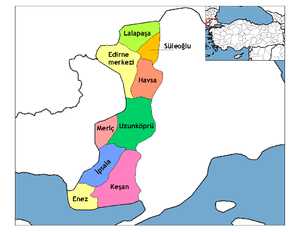Edirne
Edirne (US: /eɪˈdɪərnə, ɛˈ-/,[2][3] Turkish: [eˈdiɾne]), historically known as Adrianople (/ˌeɪdriəˈnoʊpəl/; Latin: Hadrianopolis; founded by the Roman emperor Hadrian on the site of a previous Thracian settlement named Uskudama),[4] is a city in the northwestern Turkish province of Edirne in the region of East Thrace, close to Turkey's borders with Greece and Bulgaria. Edirne served as the third capital city of the Ottoman Empire from 1369 to 1453,[5] before Constantinople (present-day Istanbul) became the empire's fourth and final capital between 1453 and 1922. The city's estimated population in 2014 was 165,979.
Edirne | |
|---|---|
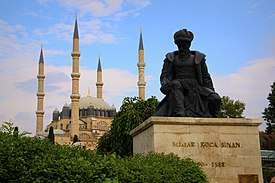 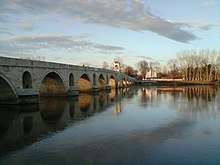  From top down, left to right: Selimiye Mosque, Meriç Bridge, Ali Pasha Bazaar, Treaty of Lausanne Monument and Museum, Trakya University (formerly Karaağaç railway station), Old Mosque, Town Hall, Historical Express | |
 Edirne Location of Edirne within Turkey  Edirne Edirne (Europe) | |
| Coordinates: 41°40′37″N 26°33′20″E | |
| Country | |
| Region | Marmara |
| Province | Edirne |
| Government | |
| • Mayor | Recep Gürkan (CHP) |
| • Governor | Dursun Ali Şahin |
| Area | |
| • Province | 6,098 km2 (2,354 sq mi) |
| • City | 844 km2 (326 sq mi) |
| Elevation | 42 m (138 ft) |
| Population | |
| • Density | 196.7/km2 (509/sq mi) |
| • Province | 400,280 |
| • City | 165,979 |
| Time zone | UTC+3 (FET) |
| Postal code | 22000 |
| Area code(s) | (+90) 284 |
| Licence plate | 22 |
Names and etymology
The city was founded as Hadrianopolis (Ἁδριανούπολις in Greek), named after the Roman emperor Hadrian. This name is still used in the modern Greek language (Αδριανούπολη, Adrianoúpoli). The Ottoman name Edirne derives from the Greek name. The name Adrianople was used in English until the Turkish adoption of the Latin alphabet in 1928 made Edirne the internationally recognized name. Bulgarian: Одрин, romanized: Odrin (pronounced [ˈɔdrin]), Albanian: Edrenë, Slovene: Odrin and Serbian: Једрене, romanized: Jedrene, are adapted forms of the name Hadrianopolis or of its Turkish version.
History


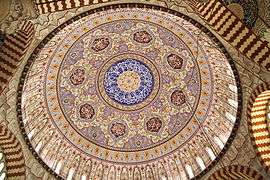
| Year | Pop. | ±% |
|---|---|---|
| 1400s | 70,000 | — |
| 1700s | 35,000 | −50.0% |
| 1800s | 33,000 | −5.7% |
| 1900s | 68,661 | +108.1% |
| 1927 | 34,528 | −49.7% |
| 1965 | 78,161 | +126.4% |
| 1970 | 84,531 | +8.1% |
| 1975 | 94,449 | +11.7% |
| 1980 | 105,503 | +11.7% |
| 1985 | 120,663 | +14.4% |
| 1990 | 124,361 | +3.1% |
| 2000 | 140,830 | +13.2% |
| 2010 | 152,993 | +8.6% |
| 2014 | 165,979 | +8.5% |
The area around Edirne has been the site of numerous major battles and sieges, from the days of the Roman Empire. The vagaries of the border region between Asia and Europe gives rise to Edirne's historic claim to be the most frequently contested spot on the globe.[6]
Antiquity
The city was (re)founded eponymously by the Roman Emperor Hadrian on the site of a previous Thracian settlement known as Uskadama, Uskudama, Uskodama or Uscudama.[4] Hadrian developed it, adorned it with monuments, changed its name to Hadrianopolis (which would be corrupted into Adrianopolis, Anglicised as Adrianople). Licinius was defeated there by Constantine I in 323, and Emperor Valens was killed by the Goths in 378 during the Battle of Adrianople (378).
Medieval period
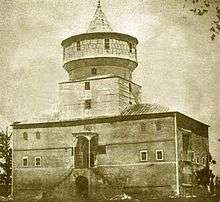
In 813, the city was temporarily seized by Khan Krum of Bulgaria who moved its inhabitants to the Bulgarian lands north of the Danube.[7]
During the existence of the Latin Empire of Constantinople, the Crusaders were decisively defeated by the Bulgarian Emperor Kaloyan in the Battle of Adrianople (1205). In 1206 Adrianople and its territory was given to the Byzantine aristocrat Theodore Branas as a hereditary fief by the Latin regime.[8] Theodore Komnenos, Despot of Epirus, took possession of it in 1227, but three years later was defeated at Klokotnitsa by Emperor Ivan Asen II of Bulgaria.
In 1361, the Ottoman Empire under Sultan Murad I invaded Thrace. Murad captured Adrianople, probably in 1369 (the date is disputed). The city became "Edirne" in Turkish, reflecting the Turkish pronunciation.[9] Murad moved the Ottoman capital to Adrianople. Mehmed the Conqueror (Sultan Mehmed II) was born in Adrianople, where he fell under the influence of some Hurufis dismissed by Taş Köprü Zade in the Şakaiki Numaniye as "Certain accursed ones of no significance", who were burnt as heretics by a certain Mahmud Pasha.[10]
The city remained the Ottoman capital for 84 years until 1453, when Mehmed II took Constantinople (present-day Istanbul) and moved the capital there.
Edirne is famed for its many mosques, domes, minarets, and palaces from the Ottoman period.
Modern period
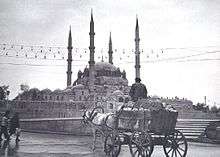
Under Ottoman rule, Adrianople was the principal city of the administrative unit, the eponymous Eyalet of Adrianople, and after land reforms in 1867, the Vilayet of Adrianople.
Sultan Mehmed IV left the palace in Constantinople and died in Adrianople in 1693.
During his exile in the Ottoman Empire, the Swedish king Charles XII stayed in the city during most of 1713.[11]
Bahá'u'lláh, the founder of the Bahá'í Faith, lived in Edirne from 1863 to 1868. He was exiled there by the Ottoman Empire before being banished further to the Ottoman penal colony in Akka. He referred to Adrianople in his writings as the "Land of Mystery".[12]
Adrianople was a sanjak centre during the Ottoman period and was bound to, successively, the Rumeli Eyalet and Silistre Eyalet before becoming a provincial capital of the Eyalet of Edirne at the beginning of the 19th century; until 1878, the Eyalet of Adrianople comprised the sanjaks of Edirne, Tekfurdağı, Gelibolu, Filibe, and İslimye.
Adrianople was briefly occupied by imperial Russian troops in 1829 during the Greek War of Independence and in 1878 during the Russo-Turkish War of 1877–1878. The city suffered a fire in 1905. In 1905 it had about 80,000 inhabitants, of whom 30,000 were Turks; 22,000 Greeks; 10,000 Bulgarians; 4,000 Armenians; 12,000 Jews; and 2,000 more citizens of unclassified ethnic/religious backgrounds.
Adrianople was a vital fortress defending Ottoman Constantinople and Eastern Thrace during the Balkan Wars of 1912–13. It was briefly occupied by the Bulgarians in 1913, following the Siege of Adrianople. The Great Powers–Britain, Italy, France, and Russia–attempted to coerce the Ottoman Empire into ceding Adrianople to Bulgaria during the temporary winter truce of First Balkan War. The belief that that government was willing to give up the city created a political scandal in the Ottoman government in Constantinople (as Adrianople was a former capital of the Empire), leading to the 1913 Ottoman coup d'état. Although it was victorious in the coup, the Committee of Union and Progress under Enver Pasha (who later proclaimed himself the "second conqueror of Adrianople", after Murad I), was unable to stop the Bulgarians from conquering the city after the fighting resumed in the Spring. The city was regained by the Ottomans during the Second Balkan War.
It was ceded to Greece by the Treaty of Sèvres in 1920 and their defeat at the end of the Greco-Turkish War, also known as the Western Front of the larger Turkish War of Independence, in 1922. During the Greek administration, Edirne (officially known as Adrianople) was the capital of the Adrianople Prefecture.
Adrianople became known in Western languages as "Edirne" circa 1930.[13] From 1934 onwards Edirne was the seat of the Second Inspectorate General, in which a Inspector General governed over the provinces Edirne, Çanakkale, Tekirdaĝ and Kırklareli.[14] The Inspectorate Generals governmental posts were abandoned in 1948,[15] but the legal framework of them was only abolished in 1952, under the government of the Democrat Party.[16]
According to the 2007 census, Edirne Province had a population of 382,222 inhabitants. The city is a commercial centre for woven textiles, silks, carpets and agricultural products.
Ecclesiastical history
Adrianople was made the seat of a Greek metropolitan and of an Armenian bishop. Adrianople is also the centre of a Bulgarian diocese, but not recognized and deprived of a bishop. The city also had some Protestants. The Latin Catholics, foreigners for the most part, and not numerous, were dependent on the vicariate-apostolic of Constantinople. At Adrianople itself were the parish of St. Anthony of Padua (Minors Conventual) and a school for girls conducted by the Sisters of Charity of Agram. In the suburb of Karaağaç were a church (Minor Conventuals), a school for boys (Assumptionists) and a school for girls (Oblates of the Assumption). Each of its mission stations, at Tekirdağ and Alexandroupoli, had a school (Minor Conventuals), and there was one at Gallipoli (the Assumptionists).
Around 1850, from the standpoint of the Eastern Catholic Churches, Adrianople was the residence of a Bulgarian vicar-apostolic for the 4,600 Eastern Catholics of the Ottoman vilayet (province) of Thrace and after 1878 - of the principality of Bulgaria. They had 18 parishes or missions, 6 of which were in the principality, with 20 churches or chapels, 31 priests, of whom 6 were Assumptionists and 6 were Resurrectionists; 11 schools with 670 pupils.In Adrianople itself were only a very few United Bulgarians, with an Episcopal church of St. Elias, and the churches of St. Demetrius and Sts. Cyril and Methodius. The last is served by the Resurrectionists, who have also a college of 90 pupils. In the suburb of Karaağaç, the Assumptionists have a parish and a seminary with 50 pupils. Besides the Eastern Catholic Bulgarians, the above statistics included the Greek Catholic missions of Malgara (now Malkara) and Daoudili (now Davuteli village in Malkara), with 4 priests and 200 faithful, because from the civil point of view belonged to the Bulgarian Vicariate.
Later however, the Roman Catholic diocese was discontinued, and exists only in name as a titular metropolitan archbishopric, under the full name Hadrianopolis in Haemimonto to distinguish it from several other titular sees named Hadrianopolis.
In 2018, archaeologists discovered remains of a Byzantine church. The church was built around 500 AD and it was an early Byzantine period building.[17]
Geography
Climate
Edirne has a borderline humid subtropical (Cfa) and hot-summer Mediterranean climate (Csa) in the Köppen climate classification, since only one summer month has less than 40 mm (1.6 in) of rainfall, preventing it from being classified as solely humid subtropical or Mediterranean. Edirne has hot, muggy, moderately dry summers and cold, wet and occasionally snowy winters.
| Climate data for Edirne (1930–2017) | |||||||||||||
|---|---|---|---|---|---|---|---|---|---|---|---|---|---|
| Month | Jan | Feb | Mar | Apr | May | Jun | Jul | Aug | Sep | Oct | Nov | Dec | Year |
| Record high °C (°F) | 20.5 (68.9) |
23.3 (73.9) |
28.0 (82.4) |
33.5 (92.3) |
37.1 (98.8) |
42.6 (108.7) |
44.1 (111.4) |
40.8 (105.4) |
37.8 (100.0) |
35.8 (96.4) |
28.0 (82.4) |
22.8 (73.0) |
44.1 (111.4) |
| Average high °C (°F) | 6.4 (43.5) |
9.1 (48.4) |
13.2 (55.8) |
19.1 (66.4) |
24.6 (76.3) |
29.1 (84.4) |
31.7 (89.1) |
31.7 (89.1) |
27.2 (81.0) |
20.5 (68.9) |
13.9 (57.0) |
8.3 (46.9) |
19.6 (67.3) |
| Daily mean °C (°F) | 2.7 (36.9) |
4.5 (40.1) |
7.6 (45.7) |
12.9 (55.2) |
18.1 (64.6) |
22.4 (72.3) |
24.8 (76.6) |
24.4 (75.9) |
19.9 (67.8) |
14.2 (57.6) |
9.1 (48.4) |
4.6 (40.3) |
13.8 (56.8) |
| Average low °C (°F) | −0.6 (30.9) |
0.3 (32.5) |
2.8 (37.0) |
7.0 (44.6) |
11.6 (52.9) |
15.3 (59.5) |
17.2 (63.0) |
17.1 (62.8) |
13.3 (55.9) |
9.1 (48.4) |
5.0 (41.0) |
1.2 (34.2) |
8.3 (46.9) |
| Record low °C (°F) | −19.5 (−3.1) |
−19.0 (−2.2) |
−12.0 (10.4) |
−4.1 (24.6) |
0.7 (33.3) |
6.0 (42.8) |
8.0 (46.4) |
8.9 (48.0) |
0.2 (32.4) |
−3.7 (25.3) |
−9.4 (15.1) |
−14.9 (5.2) |
−19.5 (−3.1) |
| Average precipitation mm (inches) | 66.7 (2.63) |
52.0 (2.05) |
51.6 (2.03) |
47.2 (1.86) |
53.3 (2.10) |
46.5 (1.83) |
32.3 (1.27) |
22.4 (0.88) |
37.2 (1.46) |
57.7 (2.27) |
68.1 (2.68) |
70.0 (2.76) |
605.0 (23.82) |
| Average precipitation days | 12.4 | 9.8 | 9.9 | 10.1 | 10.3 | 8.5 | 5.5 | 3.9 | 4.8 | 7.7 | 10.6 | 13.2 | 106.7 |
| Average relative humidity (%) | 82 | 77 | 73 | 68 | 68 | 64 | 57 | 57 | 63 | 73 | 81 | 83 | 71 |
| Mean monthly sunshine hours | 77.5 | 104.5 | 142.6 | 195.0 | 263.5 | 297.0 | 341.0 | 322.4 | 240.0 | 170.5 | 102.0 | 71.3 | 2,327.3 |
| Mean daily sunshine hours | 2.5 | 3.7 | 4.6 | 6.5 | 8.5 | 9.9 | 11.0 | 10.4 | 8.0 | 5.5 | 3.4 | 2.3 | 6.4 |
| Source 1: Turkish State Meteorological Service[18] | |||||||||||||
| Source 2: Deutscher Wetterdienst (humidity 1931–1960)[19] | |||||||||||||
Points of interest
Situated 7 km (4.3 mi) from the Greek and 20 km (12 mi) from the Bulgarian borders, Edirne is famed for its many mosques, domes and minarets. The Selimiye Mosque, built in 1575 and designed by Turkey's greatest master architect, Mimar Sinan (c. 1489/1490–1588), is one of the most important monuments in the city. It has the highest minarets in Turkey, at 70.90 m (232.6 ft) and a cupola 3 or 4 ft (0.91 or 1.22 m) higher than that of Hagia Sophia, the Byzantine Orthodox Cathedral (now museum) in Istanbul. Carrying the name of the then reigning Ottoman Sultan Selim II (r. 1566–1574), this mosque futures Turkish marble handicrafts, and it is covered with valuable tiles and fine paintings. Other notable mosques are Eski Cami (Old Mosque),[20] and Burmalı Cami (Serpent Mosque), aka Üç Şerefeli Mosque.[21]
Edirne has three historic covered bazaars: Arasta, next to Selimiye Mosque, Bedesten next to Eski Cami and Ali Paşa Çarşısı (Ali Pasha Bazaar).
Besides the mosques, there are visitor attractions in Edirne, all reflecting its rich past. The most prominent place being the Edirne Palace (Ottoman Turkish: Saray-ı Cedid-i Amire for "New Imperial Palace") in Sarayiçi quarter, built during the reign of Murad II (r. 1421–1444). Although the buildings of the palace and its bath (Kum Kasrı Hamamı) are in ruined form, the palace gate and the palace kitchen facility are restored. The Kasr-ı Adalet ("Justice Castle"), built as part of the palace complex, stands intact next to the small Fatih Bridge over the Tunca river.[22]
Another notable building in the area is the Complex of Sultan Bayezid II, an important monument with its complex construction comprising many facilities used in those times.
The Balkan Wars Memorial Cemetery is located close to the Edirne Palace, with an unknown soldier monument featuring an Ottoman soldier in front of its entrance.[23]
The historic Grand Synagogue of Edirne, abandoned and ruined, was restored and re-opened in March 2015.[24][25][26] A Roman Catholic and two Bulgarian Orthodox churches are found in the city.
Edirne has several historic arch bridges crossing over the rivers Meriç and Tundzha, which flow around west and south of the city.
There are caravansaries, like the Rustem Pasha and Ekmekcioglu Ahmet Pasha caravansaries, which were designed to host travelers, in the 16th century.
The historic Karaağaç railway station hosts today, after redevelopment, the Trakya University's Faculty of Fine Arts in Karaağaç suburb of Edirne.[23] Next to it, the Treaty of Lausanne Monument and Museum are situated.[27]
Culture
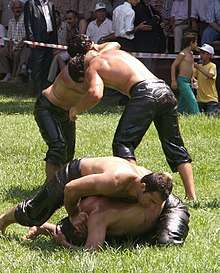
The traditional oil-wrestling tournament called Kırkpınar, is held every year in late June or early July.[28] Kakava, an international festival celebrating the Roma people is held on 5 May each year.[29]
A cultural partnership with Lörrach, Germany began in 2006. The goal is to exchange pupils and students to improve their cultural skills and understanding.
Edirne is well known for local dishes. "Ciğer tava" (breaded and deep-fried liver) is often served with a side of cacık, a cool dish of diluted strained yogurt with chopped cucumber. Also, locally-made marzipan, which has a different recipe from standard marzipan, is one of traditional desserts of Edirne.
Handmade brooms with a mirror in them are one of the cultural images of the city and a central marriage tradition. Miniature versions are still sold in gift shops.
Economy
Edirne's economy largely depends on agriculture. 73% of the working population work in agriculture, fishing, forests and hunting. The lowlands are productive. Corn, sugarbeets and sunflowers are the leading crops. Melons, watermelons, rice, tomatoes, eggplants and viniculture are important.
The through highway that connects Europe to Istanbul, Anatolia and the Middle East passes through Edirne.
Historic buildings and events have elevated tourism's role in the economy.
Industry is developing. Agriculture-based industries (agro-industries) are especially important for the city's economy.
Education
Universities
- Trakya University, which is linked with Loerrach University through the Erasmus programme of the EU.
High schools
- Beykent Educational Institutions
- 80th Year of Republic Anatolian High School (80. Yıl Cumhuriyet Anadolu Lisesi in Turkish)
- Edirne Anatolian Teacher Training High School (Edirne Anadolu Öğretmen Lisesi in Turkish: It has been transformed into Edirne Social Sciences High School)
- Edirne Anatolian Technical High School (Edirne Anadolu Teknik Lisesi in Turkish)
- Edirne Beykent High School of Science (Özel Edirne Beykent Fen Lisesi)
- Edirne Beykent High School of Anatolian (Özel Edirne Beykent Anadolu Lisesi)
- Edirne High School (Anatolian High School) (Edirne Lisesi in Turkish)
- Edirne Ilhami Ertem High School (Edirne İlhami Ertem Lİsesi in Turkish)
- Edirne Industrial Vocational High School (Edirne Endüstri Meslek Lisesi in Turkish)
- Edirne Milli Piyango Trade Profession High School (Edirne Milli Piyango Ticaret Meslek Lisesi)
- Edirne Suleyman Demirel Science & Maths High School (Edirne Fen Lisesi in Turkish)
- Edirne Yildirim Anatolian High School (Edirne Anadolu Lisesi - Yıldırım Anadolu Lisesi in Turkish)
- Edirne Fine Arts High School (Edirne Güzel Sanatlar Lisesi in Turkish)
Gallery
- Interior view of the Grand Synagogue of Edirne
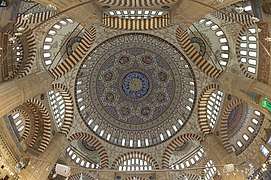 Interior view of the Selimiye Mosque, Edirne
Interior view of the Selimiye Mosque, Edirne- View of the Selimiye Mosque, Edirne
- View of the Selimiye Mosque, Edirne
- A house in Edirne from the Ottoman period
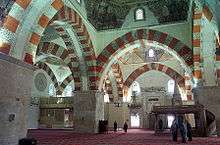 Interior of Eski Cami
Interior of Eski Cami- A historic elementary school building
 Edirne Main Street
Edirne Main Street.jpg) IV.Mehmet Hunting Kiosk
IV.Mehmet Hunting Kiosk%2C_Front.jpg)
- Fatih Bridge over the Tunca River, with the Kasr-ı Adalet (Justice Pavilion) tower seen in the background
 Ghazi Mihal Mosque
Ghazi Mihal Mosque Part of Muradiye Mosque mihrab
Part of Muradiye Mosque mihrab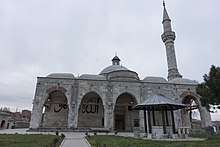 Muradiye Mosque front
Muradiye Mosque front A Roman Tower still standing
A Roman Tower still standing
Quarters
- Avrupa Kent
- Ayşekadın
- Binevler
- Esentepe
- Kaleiçi
- Karaağaç
- Kavgaz
- Kıyık
- Kirişhane
- Kooperatifevleri
- Kutlutaş
- Küçükpazar
- Muradiye
- Saraçhane
- Umur Bey
- Yıldırım
Twin cities
Notable people
- Sultans
- Bayezid I (1360—1403), Ottoman sultan from 1389 to 1402
- Mahmud I (1696—1754), Ottoman sultan from 1730 to 1754
- Mehmed the Conqueror (1432–1481), Ottoman sultan who conquered Constantinople (today Istanbul)
- Mustafa II (1664–1703), Ottoman sultan from 1695 to 1703
- Osman III (1699—1757), Ottoman sultan from 1754 to 1757
- Şahin Giray (1745-1787), last khan of Crimea
- Historical
- Caleb Afendopolo (before 1430-1499), Jewish polyhistor
- Athanasius I of Constantinople (1230—1310), Ecumenical Patriarch of Constantinople
- Athanasius V of Jerusalem (died 1844), Greek Orthodox Patriarch of Jerusalem
- Hagop Baronian (1843—1891), Ottoman Armenian writer, satirist, educator
- Elijah Bashyazi (c. 1420—1490), Karaite Jewish hakham
- Theodore Branas, Byzantine general
- Nikephoros Bryennios (ethnarch), Byzantine general
- Abraham ben Raphael Caro, 18th-century Ottoman rabbi
- Karpos Papadopoulos (1790s-1871), Member of the Filiki Eteria
- Theoklitos Polyeidis (1698-1759), Greek scholar, teacher, translator, priest and monk
- Dionysius V of Constantinople (1820-1891), Ecumenical Patriarch of Constantinople
- Joseph Halévy (1827—1917), Ottoman-born Jewish-French Orientalist and traveler
- Abdulcelil Levni (died 1732), Ottoman court painter and miniaturist
- Neşâtî (?–1674), Ottoman poet
- Georgi Valkovich (1833—1892), Bulgarian physician, diplomat and politician
- Yirmisekiz Mehmed Çelebi (died 1732), Ottoman statesman and ambassador
- Stefanos Koumanoudis (1818-1899), Greek archaeologist, university teacher, writer and translator
- Contemporary
- Cem Adrian (born 1980), Turkish singer-songwriter, author, producer and film director
- Şevket Süreyya Aydemir (1897—1976), Turkish writer, intellectual, economist, historian
- Namik Haluk Baskinci (1957—1995), Turkish architect, engineer and musician
- Atılay Canel (born 1955), Turkish football coach
- Cavit Erdel (1884—1933), Ottoman Army officer and Turkish Army general
- Hüsrev Gerede (1884-1962), Ottoman and Turkish Army officer, politician and diplomat
- Avra Theodoropoulou (1880-1863), Greek musician and activist
- Ragıp Gümüşpala (1897-1964), 11th Chief of the General Staff of the Turkish Armed Forces
- Acun Ilıcalı (born 1969), Turkish television personality and producer
- Haşim İşcan (1898-1968), Turkish high school teacher, province governor and the first elected mayor of Istanbul
- Kemal Kerinçsiz (born 1960), Turkish ultra-nationalist lawyer
- Özlem Kolat (born 1984), Turkish classical clarinet player
- Michael Petkov (1850-1921), Bulgarian Eastern Catholic priest
- Muharrem Korhan Yamaç (born 1972), Paralympics, world and European champion disabled sport shooter
- Nikos Zachariadis (1903—1973), General Secretary of the Communist Party of Greece
- Gökberk Ergeneman (born 1995) National Tennis Player
See also
- List of battles of Adrianople
- List of treaties of Adrianople
- Trakya University
References
https://www.academia.edu/23674853/Edirne_Ta%C5%9F_K%C3%B6pr%C3%BCleri_Edirne_Stone_Bridges
- "HGK" (PDF). General Command of Mapping.
- "Edirne". Collins English Dictionary. HarperCollins. Retrieved 3 August 2019.
- "Edirne". Merriam-Webster Dictionary. Retrieved 3 August 2019.
- "Edirne". Encyclopaedia Britannica. Retrieved 31 May 2018.
- "In 1363 the Ottoman capital moved from Bursa to Edirne, although Bursa retained its spiritual and economic importance." Ottoman Capital Bursa. Official website of Ministry of Culture and Tourism of the Republic of Turkey. Retrieved 19 December 2014. Contradicted by refs cited in Conquest of Adrianople
- Keegan, John (1993). A History of Warfare. Random House. pp. 70–71. ISBN 0-7126-9850-7.
- Hupchick, Dennis (2017). The Bulgarian-Byzantine Wars for Early Medieval Balkan Hegemony: silver-lined skulls and blinded armies. US: Palgrave Macmillan. p. 107. ISBN 9783319562056.
- Saint-Guillain, G. (1216) Identities and Allegiances in the Eastern Mediterranean after 1204, Routledge, p. 66
- "It served as the capital of the Ottoman Empire from 1413 until 1458 and flourished as an administrative, commercial, and cultural centre." "Edirne" Encyclopædia Britannica. Retrieved 19 December 2014
- John Kingsley Birge, The Bektashi Order of Dervishes, 1982 (p 60 - 62)
- "Adrianopel" in Nordisk familjebok (2nd edition, 1904)
- "Bahá'í Reference Library - The Kitáb-i-Aqdas, Page 196". Reference.bahai.org. 31 December 2010. Retrieved 30 July 2011.
- Romein, Jan (translated by R. T. Clark). The Asian Century: A History of Modern Nationalism in Asia (De eeuw van Azie). University of California Press, 1962. p. 170. "In 1930 geographical names were 'turkicized'. [...] Adrianople Edirne, and so on."
- Cagaptay, Soner (2006). Islam, Secularism, and Nationalism in Modern Turkey; Who is a Turk. Routledge. p. 47.
- Bayir, Derya (2016-04-22). Minorities and Nationalism in Turkish Law. Routledge. p. 141. ISBN 978-1-317-09579-8.
- Bozarslan, Hamit (2008-04-17). Fleet, Kate; Faroqhi, Suraiya; Kasaba, Reşat; Kunt, I. Metin (eds.). The Cambridge History of Turkey. Cambridge University Press. p. 343. ISBN 978-0-521-62096-3.
- Remains of 1500-year old Byzantine church found in Turkey's northwest
- "Resmi İstatistikler: İllerimize Ait Genel İstatistik Verileri" (in Turkish). Turkish State Meteorological Service. Archived from the original on 11 January 2019. Retrieved 10 January 2019.
- "Klimatafel von Edirne / Türkei" (PDF). Baseline climate means (1961–1990) from stations all over the world (in German). Deutscher Wetterdienst. Retrieved 12 January 2019.
- Edirne: Eski Cami - Ulu Cami
- "Üç Şerefeli Cami" (in Turkish). Edirne Vergi Dairesi Başkanlığı. Retrieved 9 May 2015.
- "Saraylar" (in Turkish). Edirne Vergi Dairesi Başkanlığı. Retrieved 9 May 2015.
- "Anıtlar" (in Turkish). Edirne Vergi Dairesi Başkanlığı. Retrieved 9 May 2015.
- "Edirne Sinagogu 46 yıl sonra yeniden ibadete açıldı". Sabah (in Turkish). 26 March 2015. Retrieved 27 March 2015.
- "Büyük Sinagog'da 46 yıl sonra ilk ibadet". CNN Türk (in Turkish). 26 March 2015. Retrieved 27 March 2015.
- Özmen, Engin (25 March 2015). "Edirne'de Büyük Sinagog açılışa hazır". Hürriyet (in Turkish). Retrieved 27 March 2015.
- "Edirne Anıtları-Lozan Anıtı" (in Turkish). Edirne Vergi Dairesi Başkanlığı. Retrieved 15 May 2015.
- Hong, Fan (2017). Sport in the Middle East: Power, Politics, Ideology and Religion. Routledge. p. 58. ISBN 978-1351547963.
- "Kakava'da ateş yakıldı". www.hurriyet.com.tr (in Turkish). Retrieved 2019-03-09.
Further reading
- Gökbilgin, M. Tayyib (1991). "Edirne". Encyclopaedia of Islam, Volume 2 (2nd ed.). Leiden: Brill. pp. 683–686. ISBN 90-04-07026-5.
- Wasti, Syed Tanvir (July 2004). "The 1912-13 Balkan Wars and the Siege of Edirne". Middle Eastern Studies. Taylor & Francis, Ltd. 40 (4): 59–78. doi:10.1080/00263200410001700310. JSTOR 4289928.
- Yerolympous, Alexandra. "A Contribution to the Topography of 19th Century Adrianople". Balkan Studies: 49–72.
External links
| Wikisource has the text of a 1911 Encyclopædia Britannica article about Edirne. |
| Wikimedia Commons has media related to Edirne. |

